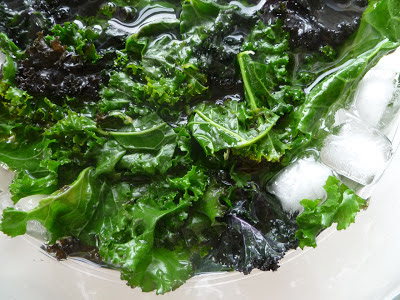Here in the Willamette Valley, we've been socked in for days with fog and drizzle. To combat the gloomy grayness, I recommend eating outrageously colorful food. From our stash of Open Oak Farm beets and kale, I made magenta pasta dough,
and blanched kale leaves for a vivid green winter pesto brightened with lemon zest.
The noodles leeched a little of their color during cooking, going from magenta to hot pink in the lipstick color spectrum, but they were still bright enough to put a smile on everyone's face.
Kale Pesto
1 bunch kale
1/2 cup walnuts
1/2 cup olive oil
2 garlic cloves
zest from one lemon
fresh ground pepper
salt to taste
1. Set a large pot of salted water to boil. Rinse the kale leaves and cut the leaves from the center ribs. Prepare a large bowl of ice water. When the water is boiling, add the kale leaves and blanch for one minute until the leaves are bright green but not too wilted. Remove the leaves from the water with a large slotted spoon or tongs and submerge into the ice water to prevent them from over-cooking. You can save the hot kale water for cooking the pasta. Squeeze the kale leaves to remove as much water as possible and reserve.
2. Heat a dry skillet and toast the unpeeled garlic cloves until they start to blacken and soften. Now toast the walnuts for a couple of minutes, stirring, until they smell fragrant but being careful that they don't burn. Peel the garlic cloves and put them in the bowl of a food processor along with the toasted walnuts. Add the lemon zest and pulse until the walnuts are small pieces. Now add the blanched kale leaves, a grind of fresh pepper, and a generous pinch of salt. Process while pouring in the olive oil until you have a fairly smooth paste. Taste and add more salt, pepper, olive oil, or some juice from the zested lemon as desired. Transfer the pesto to a large serving bowl.
serves four
2 small or 1 medium beet
3 eggs
~3 cups all purpose flour
1. Peel and quarter the beets and roast them at 350 degrees until soft, for about half an hour. Alternatively, you could boil or steam them.
2. In a food processor, puree the cooked beet. Now add the eggs and puree until smooth. Then add 2 1/2 cups flour and process. If the dough is too sticky, keep adding flour until it forms a firm ball and no longer sticks to your finger when pressed.
3. Transfer the dough to a floured surface and cut it into about a dozen pieces. Flatten the pieces through a hand-crank pasta maker, dusting with flour as needed, and cut into fettucini.
4. While processing the dough, get a large pot of salted water heating (this could be the same water that you blanched the kale leaves in). When the water is at a rolling boil, put in the cut pasta and use tongs to separate the pieces. Reserve a half cup of pasta water in case you want to thin the pesto a little. The pasta will be done shortly after the water comes back to a boil. Taste it to make sure it is cooked, and drain. Immediately toss the pasta with the pesto. Add a little pasta water if it seems too dry. Serve with plenty of freshly grated parmesan cheese. Alternatively, or in addition, toss in cubed feta or ricotta salata. Enjoy.


















